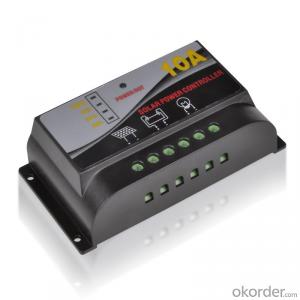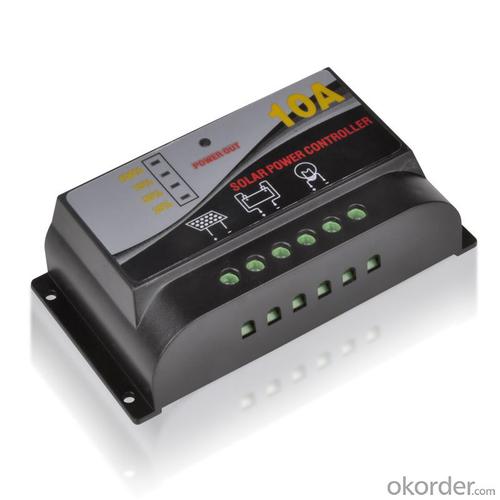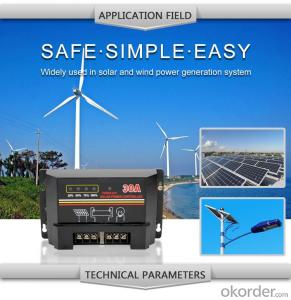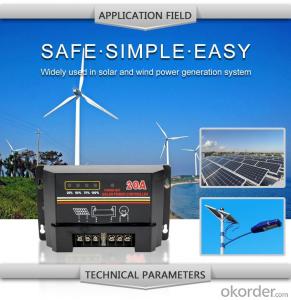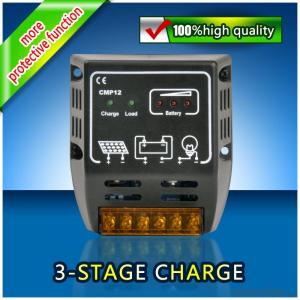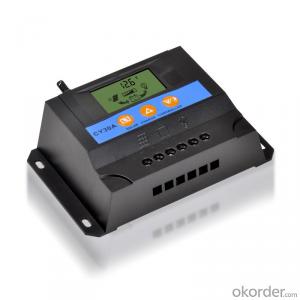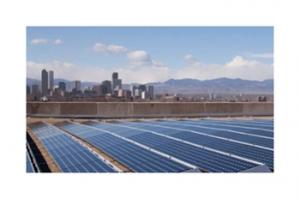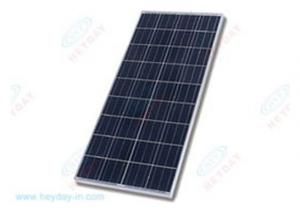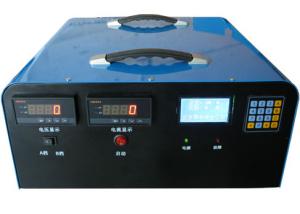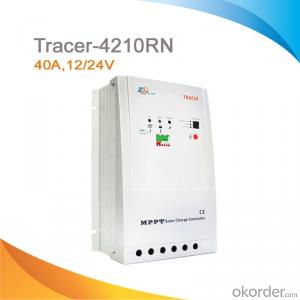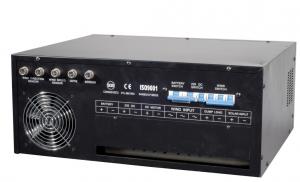Solar Panel Controllers 12v - DM110A Solar LCD Controller with Best Price Hot Selling Model
- Loading Port:
- China main port
- Payment Terms:
- TT or LC
- Min Order Qty:
- 1 unit
- Supply Capability:
- 10000 unit/month
OKorder Service Pledge
OKorder Financial Service
You Might Also Like
Product Introduction
Solar controller is control device which can control solar panel and transform solar energy into electricity then store to the battery bank. Solar controller is the most important part in offgrid system, whose performance has much effect on life expectancy and operation of the whole system, especially the battery expectancy.
Application Areas
Standalone Photovoltaic power station
Standalone Domestic household photovoltaic power system
Mobil communication base stations, expressway and other non-residential regions.
Coastal islands, remote mountainous, border posts for regions shortage of or without electricity.
Government demonstration projects, landscape lighting project etc.
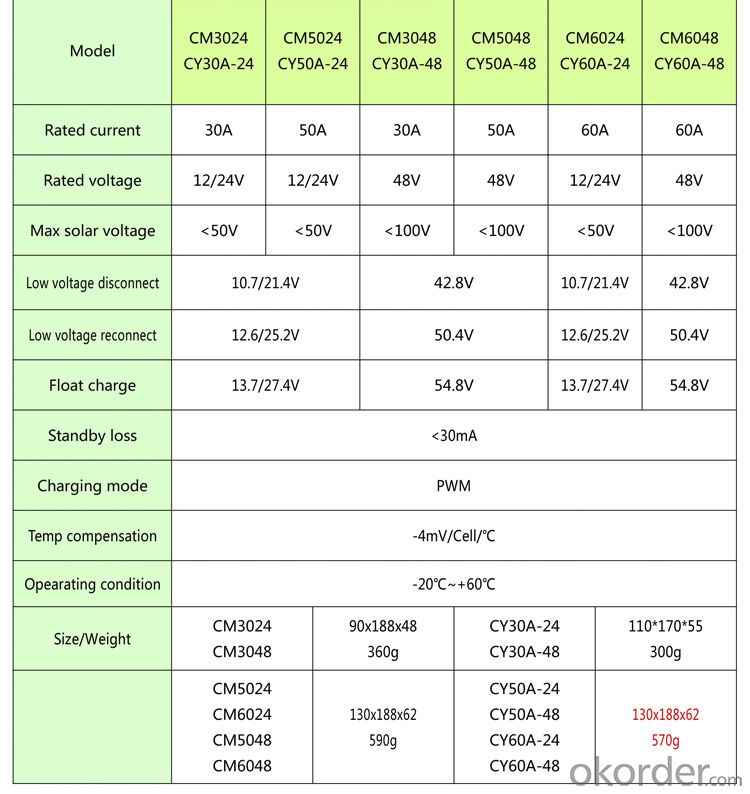

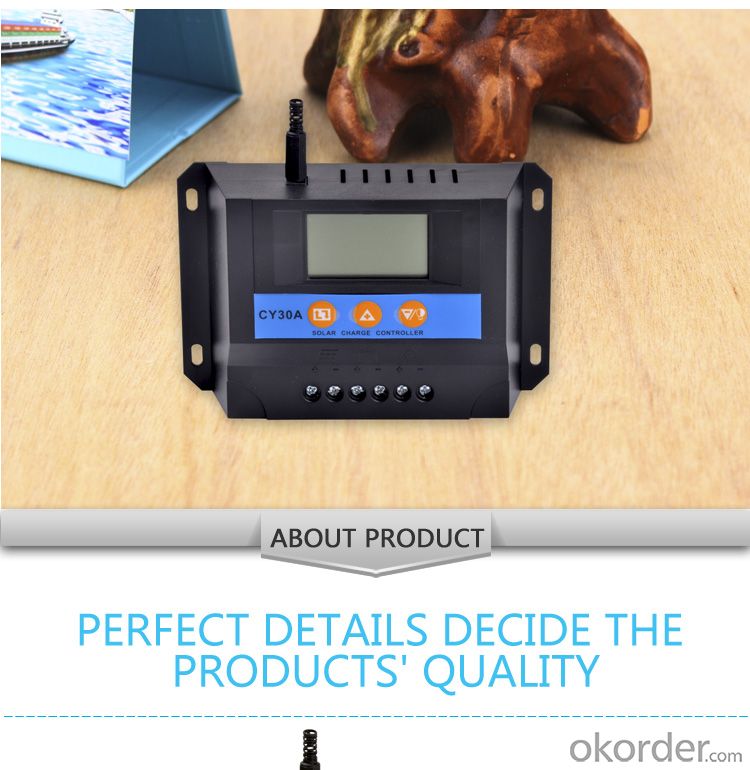
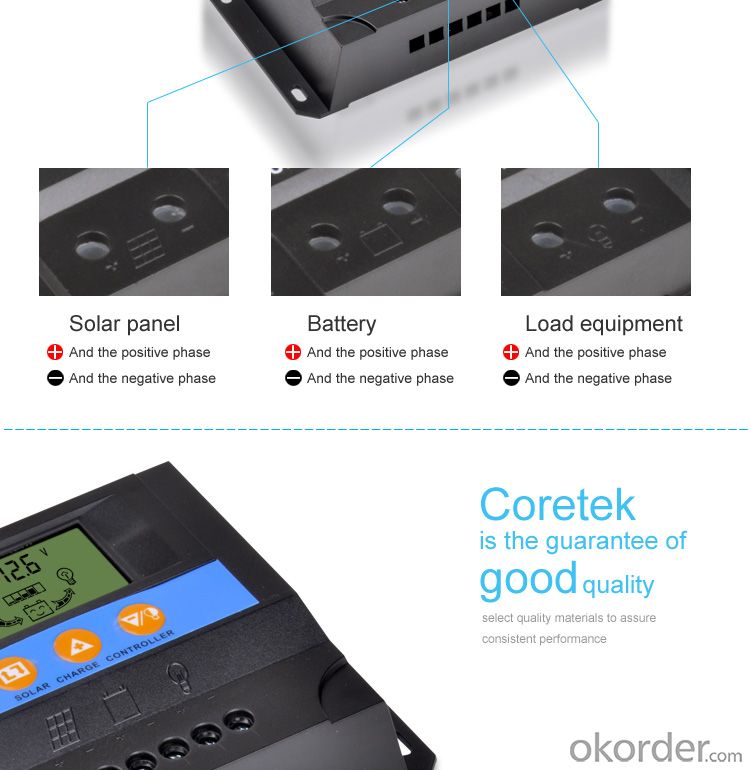
- Q: Can a solar controller be used with a solar-powered warehouse or distribution center?
- Yes, a solar controller can be used with a solar-powered warehouse or distribution center. A solar controller is essential for regulating the flow of electricity from the solar panels to the batteries, ensuring optimal charging and preventing overcharging or damage. It helps maximize the efficiency and lifespan of the solar power system, making it an essential component for any solar-powered facility, including warehouses and distribution centers.
- Q: How does a solar controller handle temperature compensation for the battery?
- A solar controller handles temperature compensation for the battery by adjusting the charging voltage based on the battery's temperature. The controller monitors the battery's temperature and compares it to a predetermined temperature compensation curve. This curve determines the appropriate charging voltage for the battery at different temperature levels. When the battery is cold, the controller increases the charging voltage to ensure efficient charging and prevent undercharging. In cold temperatures, the battery's internal resistance increases, which can lead to a drop in charging efficiency. By increasing the charging voltage, the controller compensates for this increase in resistance and provides the necessary energy to fully charge the battery. On the other hand, when the battery is hot, the controller reduces the charging voltage to prevent overcharging. High temperatures can accelerate the battery's chemical reactions, leading to increased gassing and loss of electrolyte. By lowering the charging voltage, the controller prevents overcharging, which not only prolongs the battery's lifespan but also ensures its safety. Overall, the temperature compensation feature of a solar controller optimizes the charging process by adjusting the charging voltage to match the battery's temperature. This helps maintain the battery's performance, prolong its lifespan, and ensure efficient and safe charging.
- Q: Can a solar controller be used with solar panels that are connected to a solar air conditioning system?
- Yes, a solar controller can be used with solar panels that are connected to a solar air conditioning system. A solar controller is typically used to regulate the charging and discharging of batteries in a solar power system. In the case of a solar air conditioning system, the solar controller can help manage the power generated by the solar panels and ensure that it is efficiently utilized to power the air conditioning unit. This helps optimize the system's performance and maximize energy savings.
- Q: What are the advantages of using a solar controller in a solar system?
- Utilizing a solar controller in a solar system offers multiple benefits: 1. Energy management efficiency: The inclusion of a solar controller allows for effective management of the energy generated by the solar panels. It regulates the electricity flow from the panels to the battery or grid, ensuring optimal system efficiency. 2. Battery safeguarding: Solar controllers prevent battery overcharging and deep discharging. By monitoring battery voltage and current, they ensure optimal charging and protection against damage, extending battery lifespan. 3. System security: Solar controllers safeguard the system against potential electrical faults, such as overvoltage or short circuits, which can harm the panels or other components. This guarantees the overall safety of the solar system. 4. Improved performance in diverse weather conditions: Solar controllers possess built-in features that enable them to adjust charging parameters based on weather conditions. This maximizes solar panel energy output, even in cloudy or low-light conditions. 5. Remote monitoring and control: Many solar controllers offer advanced features like remote monitoring and control. This allows users to conveniently monitor system performance and make necessary adjustments remotely, providing flexibility. 6. Cost-effectiveness: By optimizing the charging process and preventing battery damage, solar controllers reduce maintenance and replacement costs. Additionally, they maximize energy output, resulting in significant savings on electricity bills. In summary, incorporating a solar controller into a solar system yields numerous advantages, including efficient energy management, battery protection, system security, improved performance in diverse weather conditions, remote monitoring and control, and cost-effectiveness.
- Q: What is the maximum load current in standby mode of a solar controller?
- Typically, the maximum load current in standby mode for a solar controller is very low or zero. Standby mode refers to when the solar controller is not actively charging or discharging the battery, but it is still operational and ready to perform its functions. During this mode, the load current is minimized to save energy and prolong the battery life. In some cases, the load circuit may be completely disconnected to prevent any current flow. However, the specific maximum load current in standby mode can vary depending on the design and specifications of the solar controller. It is important to consult the manufacturer's documentation or product specifications for accurate information about the maximum load current in standby mode for a specific solar controller model.
- Q: How does a solar controller handle battery low voltage protection?
- A solar controller handles battery low voltage protection by monitoring the voltage level of the battery. When the voltage drops below a certain threshold, the controller automatically disconnects the load from the battery to prevent over-discharging, which can damage the battery. This helps to prolong the lifespan of the battery and ensures its optimal performance.
- Q: How do you test the functionality of a solar controller?
- To test the functionality of a solar controller, you can follow these steps: 1. Ensure that the solar controller is properly installed and connected to the solar panel and battery. 2. Check the display or indicator lights on the controller to ensure they are functioning correctly. 3. Verify that the solar controller is receiving power from the solar panel by checking the voltage readings on the controller's display or using a multimeter. 4. Test the charging functionality by monitoring the battery voltage and ensuring it is increasing when the solar panel is exposed to sunlight. 5. Check if the solar controller is properly regulating the charging process by observing if it prevents overcharging or over-discharging of the battery. 6. Test the load control feature by connecting a load, such as a light bulb or fan, to the controller's load terminals and ensuring it operates as expected. 7. If applicable, test any additional features of the solar controller, such as timers or temperature compensation, to ensure they are functioning correctly. 8. Finally, monitor the solar controller's performance over a period of time to ensure it consistently operates as intended.
- Q: What is the maximum current rating for a solar controller?
- The maximum current rating for a solar controller depends on the specific model and its design. Generally, solar controllers are available in a range of current ratings to accommodate different solar panel setups and system requirements. The maximum current rating is typically mentioned in the product specifications provided by the manufacturer. It is important to select a solar controller that can handle the maximum current produced by the solar panels in your system to ensure efficient and safe operation.
- Q: Can a solar controller be used with a solar-powered security camera system?
- Yes, a solar controller can be used with a solar-powered security camera system. A solar controller helps regulate and optimize the charging of batteries connected to solar panels, ensuring efficient power management for the security camera system. This helps maintain a consistent power supply, extend battery life, and maximize the effectiveness of the solar-powered security camera system.
- Q: How do I connect solar panels to a solar controller?
- Follow these steps to connect your solar panels to a solar controller: 1. Begin by positioning your solar panels in a location that receives maximum sunlight throughout the day. Make sure they are securely mounted and properly angled for optimal sun exposure. 2. Locate the positive and negative terminals on your solar panels, which are typically labeled as "+" and "-". Consult the user manual or markings on the panels for accurate identification. 3. Once you have found the terminals, make the connections. Attach the positive terminal of the first solar panel to the positive input terminal of the solar controller using a solar panel cable or wire with appropriate connectors. Repeat this step for the negative terminals, connecting the negative terminal of the first solar panel to the negative input terminal of the solar controller. 4. If you have multiple solar panels, follow the solar controller's specifications and your energy requirements to determine whether to connect them in series or parallel. In series connections, link the positive terminal of one panel to the negative terminal of the next panel. In parallel connections, connect all positive terminals together and all negative terminals together. 5. Double-check all the connections to ensure they are secure. Loose connections can result in power loss and inefficiency. 6. Finally, connect the solar controller to your battery bank or power inverter. Most solar controllers have separate terminals for battery connections, labeled as "+" and "-". Connect the positive terminal of the battery to the positive output terminal of the solar controller, and the negative terminal of the battery to the negative output terminal of the solar controller. 7. After completing the connections, power on the solar controller and monitor the charging status. The solar controller will regulate the power flow from the solar panels to the battery bank, ensuring efficient charging and preventing overcharging. Always refer to the user manual provided with your specific solar panels and solar controller for any manufacturer-specific instructions or guidelines.
Send your message to us
Solar Panel Controllers 12v - DM110A Solar LCD Controller with Best Price Hot Selling Model
- Loading Port:
- China main port
- Payment Terms:
- TT or LC
- Min Order Qty:
- 1 unit
- Supply Capability:
- 10000 unit/month
OKorder Service Pledge
OKorder Financial Service
Similar products
Hot products
Hot Searches
Related keywords
